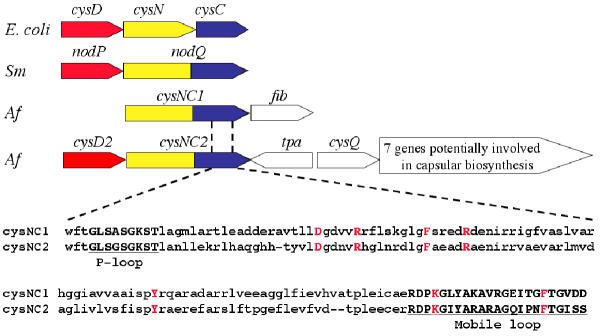Figure 6.
Organization of the proposed genes involved in PAPS formation in A. ferrooxidans. Top: Comparison of the organization of genes involved in the synthesis of PAPS in E. coli and Sinorhizobium meloti (Sm) with the suggested organization of orthologous genes in A. ferrooxidans (Af). Located downstream of cysNC1 and cysNC2 inA. ferrooxidans, and potentially forming operons with these genes, are fib (weak similarity to a gene potentially encoding a fibronectin-like binding protein involved in cell adhesion), tpa (transposase), cysQ (3'(2'),5'-bisphosphate nucleotidase) and an additional seven genes possibly encoding capsular biosynthesis. CysD and nodP are orthologs of cysD2. Bottom: Alignment of part of the C-terminal region of the proposed CysNC1 and CysNC2, corresponding to the putative kinase domain, showing conserved motifs and amino acids characteristic of this domain. Underlined and shown in bold are the P-loop and Mobile loop motifs and (in bold red) are amino acids that have been demonstrated to be critical in the kinase reaction [36]. These include the proposed MgATP-interacting Asp (D), two Phe (F) residues that straddle the adenine ring of bound APS, two Arg (R) residues that salt-link to the phosphosulfate group of APS, a Tyr (Y) that helps align the first Arg residue and a Lys (K) in an allosteric switch region.

